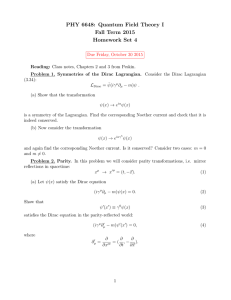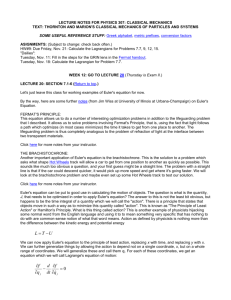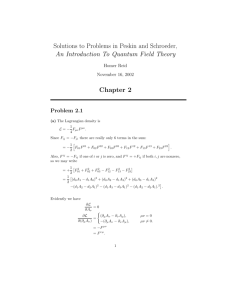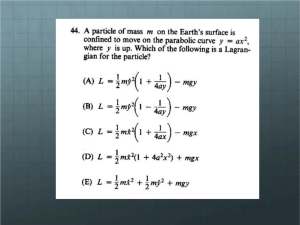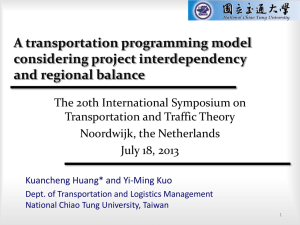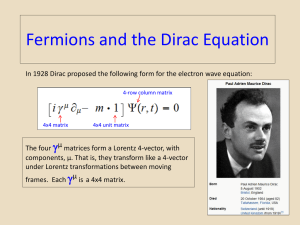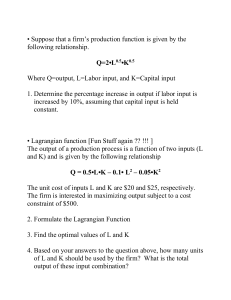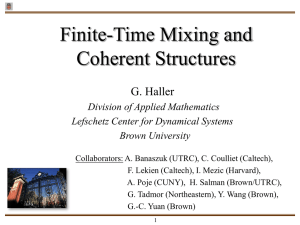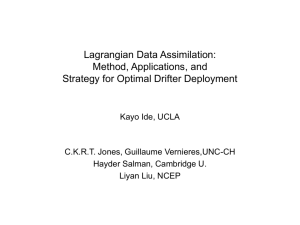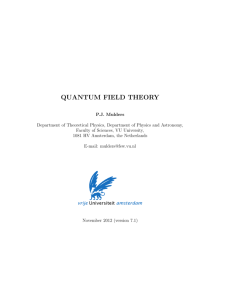Physics 772 Peskin and Schroeder Problem 3.4 Problem 3.4 a) We
advertisement
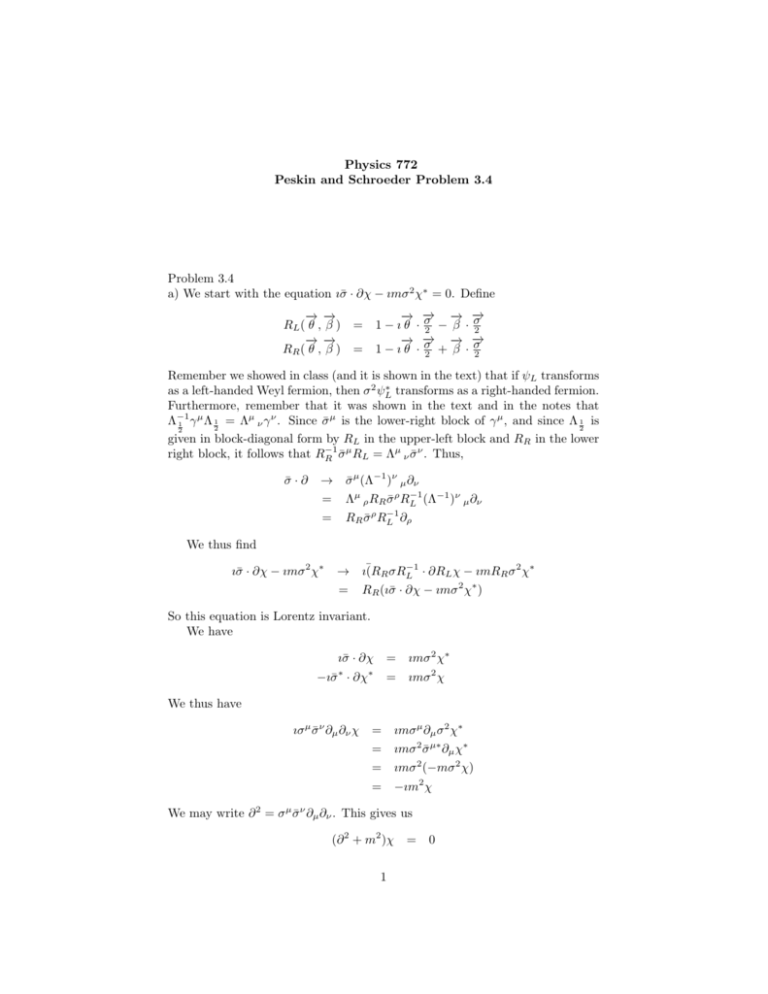
Physics 772
Peskin and Schroeder Problem 3.4
Problem 3.4
a) We start with the equation ı¯ · @
! !
RL ( ✓ , )
! !
RR ( ✓ , )
2 ⇤
ım
=
1
=
1
= 0. Define
! ! ! !
ı✓ · 2
· 2
! ! ! !
ı✓ · 2 + · 2
Remember we showed in class (and it is shown in the text) that if L transforms
⇤
as a left-handed Weyl fermion, then 2 L
transforms as a right-handed fermion.
Furthermore, remember that it was shown in the text and in the notes that
⇤ 1 1 µ ⇤ 12 = ⇤µ ⌫ ⌫ . Since ¯ µ is the lower-right block of µ , and since ⇤ 12 is
2
given in block-diagonal form by RL in the upper-left block and RR in the lower
right block, it follows that RR 1 ¯ µ RL = ⇤µ ⌫ ¯ ⌫ . Thus,
¯·@
!
=
=
¯ µ (⇤
⇤
1 ⌫
)
µ
⇢
µ @⌫
RL 1 (⇤ 1 )⌫ µ @⌫
⇢ RR ¯
RR ¯ ⇢ RL 1 @ ⇢
We thus find
ı¯ · @
2 ⇤
ım
!
=
ı¯(RR RL 1 · @RL
RR (ı¯ · @
ım
ımRR
2 ⇤
So this equation is Lorentz invariant.
We have
ı¯ · @
ı¯ ⇤ · @
⇤
=
ım
2 ⇤
=
ım
2
We thus have
ı
µ ⌫
¯ @µ @⌫
=
ım
µ
=
ım
2 µ⇤
ım
2
=
=
We may write @ 2 =
@µ
( m
2
ım
¯ @µ @⌫ . This gives us
1
=
⇤
¯ @µ
µ ⌫
(@ 2 + m2 )
2 ⇤
0
2
)
)
2 ⇤
b) We have
S
Z
=
S⇤
Z
=
†
d4 x[
ım
(
2
ı¯ · @ +
†
d4 x[ ı(@µ
T
ım
(
2
)¯ µ
† 2 ⇤
2
† 2 ⇤
)]
T
2
)]
Where we have used the fact that ¯ † = ¯ . Partially integrating the first term
gives
Z
ım † 2 ⇤
T 2
S⇤ =
d4 x[ı † ¯ µ @µ
(
)]
2
= S
⇤
a
Varying with respect to
gives us the Euler-Lagrange equation
ım
(
2
µ
⇤
a )ı¯ab @µ b
(
⇤
a
Moving the
⇤ 2
b ba (
⇤
a)
⇤
2 ⇤
a ) ab b )
+(
=
0
all the way to the left gives
ı¯ · @
Similarly, varying with respect to
⇤ µ
b )¯ba (
ı(@µ
a)
2 ⇤
ım
a
=0
yields
ım
2
( b ba
( a) + (
2
2
ım b ba
( a)
=
=
2 ⇤
a ) ab b )
We then get
ı(¯ µ )T @µ
µ ⇤
ı(¯ ) @µ
⇤
⇤
=
ım(
=
2 T
)
2
ım
which is the conjugate of the Majorana equation.
c) We may write the Dirac Lagrangian as
L
Substituting in
L
=
ı
=
ı
=
ı
†
1¯
†
1¯
†
1¯
¯(ı/
@
=
=
ı
L
=
·@
·@
·@
1
1,
·@
R
+ ı( ı
1
+ı
1
+ı
Note that if we take
we had in part b).
m)
†
L¯
2
1
+ı
=i
†
R
2 ⇤
2,
·@
R
m(
2
†
L
R
+
†
R
L)
we find
2 ⇤
m(
2)
† 2 ⇤
⇤
· @ 2 ım( 1
2
@ 2 + ım( T2 2 1
T
2
⇤
T
2 ¯
†
2¯ ·
=
L
) · @(i
†
2 ⇤
2)
1 (i
T 2
1)
2
† 2 ⇤
2)
1
+( ı
T
2
2
)
1)
we get (up to a factor of 2) the same Lagrangian
2
d) We showed in class that the Lagrangian was invariant under the symmetry
! e ı✓ . Since this symmetry multiplies L and R by the same phase, we
find the global symmetry
ı✓
! e
1
! eı✓
2
1
2
Plugging into the Lagrangian, it is clear that the phases cancel in each term.
For the theory of part b), we find
@µ J µ
=
@µ (
† µ
=
(@µ
†
=
†
(
¯
)
†
)¯ µ +
†
¯·@ ) +
¯·@
†
† 2 ⇤ †
=
m(
=
2m<(
¯·@
† 2 ⇤
) +m
† 2 ⇤
)
The divergence is proportional to the mass, because the mass term breaks the
symmetry in ( T and both transform with the same phase under the symmetry).
For the theory of part c), we find
@µ J µ
† µ
@µ (
1)
1¯
†
2<(( 1 ¯ · @ 1 ) (
=
† µ
2)
2¯
†
2 ¯ · @ 2 ))
@µ (
=
The Dirac equation can be written in terms of Weyl spinors as
ı¯ · @
ı ·@
L
m
R
=
0
R
m
L
=
0
This can be rewritten as
ı¯ · @
2 ⇤
¯ ·@
1
⇤
2
=
ım
=
m
2 ⇤
2
1
which gives us
@µ J µ
Now one can write
So
† 2 ⇤
1
2
=
=
† 2 ⇤
2
1
2m<(
⇤a 2 ⇤b
2
ab 1
=
@µ J µ
=
† 2 ⇤
1)
2
⇤b 2 ⇤a
1 ab 2
=
⇤b 2 ⇤a
1 ba 2
=
† 2
2.
1
0
This is because the current we have written is the current for the symmetry of
the Lagrangian we found above.
Finally, want to construct a theory of N two-component fermions with O(N )
symmetry. We thus are not interested in a symmetry involving complex phases,
3
but we do want to consider the possibility of an odd number of fields. So we can
take the theory from part b) as our starting point. Consider the Lagrangian
L
N
X
=
†
i ı¯
i=1
·@
i
+
ım
(
2
T
i
2
i
† 2 ⇤
i)
i
Nothing in the Lagrangian acts on the i index, so it’s easy to see that, if M is
a matrix in the fundamental representation of O(N ) (so M T M = 1, and M is
real), then this Lagrangian is invariant under i ! Mji j .
e) So we quantize the Majorana theory of parts a) and b) by taking
{
a (x),
†
b (y)}
=
ab
(3)
(x
y)
Now for the Lagrangian in part b), the kinetic term (the term involving derivatives) is the same as for the Weyl theory of the left-handed spinor. So we may
define ⇡a (x) = ı †a (x).
{
a (x), ⇡b (y)}
=
ı
ab
(3)
(x
y)
As we remember from computing the Hamiltonian for the Dirac theory (or any
theory where the kinetic term is linear), the time derivative term drops from
the Hamiltonian, and we are only left with the other terms. So we get
Z
!
ım T 2
† 2 ⇤
H =
d3 x[ † ı! · @
(
)]
2
Z
!
ı
T!
⇤ ! ⇤
† 2 ⇤
=
d3 x [ † ! · @
· @
m( T 2
)]
2
Z
ı
T
† 2 ⇤
=
d3 x [ † (@0
m 2 ⇤)
( @0 ⇤ m 2 ) m( T 2
)]
2
Z
Z
ı
=
d3 x [ † @0 + T @0 ⇤ ] = d3 x[ı † @0 ]
2
where in the second line we took the hermitian conjugate, and then interchanged
the two fields. Remember that satisfies the Klein-Gordon equation, we know
it satisfies the dispersion relation ! 2 = k 2 + m2 . So as usual, we expand in
solutions of the wave equation (here, the Majorana equation), with annihilation
operators multiplying the solutions with space-time dependence e ıp·x . We thus
get
Z
H =
dN ! a†N aN
up to a normal-ordering constant. Equivalently, we can note from part c) that
the Majorana Lagrangian is the same as the Dirac Lagrangian with the identi⇤
fication R (x) = ı 2 L
(x). This is the same as saying C (x)C = (x). This
identification reduces implies the identification b!
p = a!
p ; in other words, identifying a Majorana particle with its anti-particle. This means that the Hamiltonian for the Majorana Lagrangian can be written in terms of the oscillators
we had defined for the Dirac theory in the same way, but with the number of
oscillators reduced by a factor of two due to the identification.
4
Physics 772
Peskin and Schroeder Problem 3.5
Problem 3.5
a) We start with
L
=
⇤ µ
+
†
=
ı✏T
2
=
✏F +
@µ
@
ı¯ · @ + F ⇤ F
Under
F
2 ⇤
·@
†
✏
ı✏ ¯ · @
=
we find
L
=
@µ
⇤ µ
@ ( ı✏T
+(✏F +
=
ı@µ
†
⇤ T
✏
ı@µ
+(✏
'
'
ı✏T
T
2
2 µ
@
⇤
T
⇤ T
2 µ
✏
2
2
@
·@
(@ 2
⇤
) + @µ ( ı✏T
⇤
)
)† @ µ +
2
2 ⇤ †
·@
+(✏ F + ✏
=
2
⇤
†
†
ı¯ · @(✏F +
2 ⇤
·@
†
✏ )
†
✏ ) ı¯ · @ + F ( ı✏ ¯ · @ ) + ( ı✏ ¯ · @ ) F
+ ı(@µ
·@
⇤
ı
)
2 ⇤ µ
✏ @
@µ
⇤
†
ı¯ µ (✏F +
†
)ı¯ · @ + F ( ı✏ ¯ · @ ) + (ı@µ
2 ⇤ µ
@µ
✏ (@ 2 ) + ı
† µ ⌫
+ ı(@µ
)ı¯ · @
†
†
)
✏ @
† 2 ⇤
¯
†
·@
¯ ✏)F
ı¯ ( · @
2 ⇤
ı✏T
✏ @µ @⌫
✏ )
† µ
2 ⇤
µ
2 ⇤
✏ )
2 µ ⌫
¯
@µ @⌫
0
where the ' is used after integration by parts, where the total derivative terms
have been dropped. So the change in the Lagrangian is indeed a total divergence.
b) We have
1
L =
m F + ım T 2 + (c.c.)
2
1
⇤
Under the variation given above we have
( L)
=
m( ı✏T
1
)F + m ( ı✏† ¯ · @ ) + ım
2
2
1
+ ım(✏F +
2
ım✏T
=
2
F
1
+ ım(✏T F
2
=
=
=
=
2 ⇤ T
·@
2
✏ )
2 T
2
·@ )
2
2 ⇤
·@
(✏F +
✏ )
+ (c.c.)
1
ım ✏† ¯ · @ + ım
2
✏†
T
T
2
1
✏F + ım
2
T
¯ ⇤ · @ ✏⇤
+ (c.c.)
1
1
ım ✏† ¯ · @ + ım T 2 ✏F + ım T ¯ ⇤µ ✏⇤ @µ
2
2
1
1
+ ım✏T 2 F
ım✏† ¯ µ @µ + (c.c.)
2
2
1
1
1
1
ım T 2 ✏F + ım T ¯ ⇤µ ✏⇤ @µ
ım✏T 2 F + ım✏† ¯ µ @µ + (c.c.)
2
2
2
2
1
1
1
1
µ
µ b
2 b
2 b
ım a ab
✏ F + ım a ¯ba ✏⇤b @µ
ım✏a ab
F + ım✏⇤a ¯ab
@µ + (c.c.)
2
2
2
2
0
ım✏T
2
F
We now have
L
=
@µ
⇤ µ
@
†
+
ı¯ · @ + F ⇤ F + m F + m
⇤
1
F ⇤ + ım
2
T
1
ım
2
2
† 2 ⇤
The Euler-Lagrange equations for F and F ⇤ are then
F⇤
=
m
F
=
m
⇤
Substituting in gives us
L
=
@µ
⇤ µ
@
m2
⇤
+
†
ı¯ · @ +
ım
(
2
T
† 2 ⇤
2
)
In this equation we see that the fermion has a mass term of the form given in
problem 3.4, and the mass is the same as that of the scalar.
c) We now have
L
=
@µ ⇤i @ µ i + †i ı¯ · @ i + Fi⇤ Fi
✓
@W [ ]
ı @2W [ ] T 2
+ Fi
+
@ i
2 @ i@ j i
j
+ c.c.
◆
The top line of the Lagrangian is just the Lagrangian we considered in part a),
and we know that it is invariant under supersymmetry up to a total divergence.
2
The variation of the second line is given by
L2
=
Fi
+
=
ı @2W [ ]
((
2 @ i@ j
( ı✏† ¯ · @
+
+ı
+
+
2
j
ı @3W [ ]
2 @ i@ j @ k
T
i
+
2
j)
·@
2 ⇤ T
2
✏ )
i
2
i
j
2
j)
+
+
T
i
2
2
j)
+
2
j
ı @3W [ ]
( ı✏T
2 @ i@ j @ k
·@
(✏Fj +
j
2
2 ⇤µ
2
)
j @µ i
+
ı @2W [ ]
( ✏† ¯ µ
2 @ i@ j
j @µ i
+
T
i
✏ @µ
2
T
k) i
b
j
¯ ⇤µ ✏⇤ @µ
a µ ⇤b
j ¯ba ✏ )@µ i
+
+ c.c.
2 b
c 2 d
ab k )( i cd j )
j)
@2W [ ] 1 @3W [ ]
+
(✏a
@ i@ j
2 @ i@ j @ k
ı @2W [ ]
µ
( ✏⇤a ¯ab
2 @ i@ j
j)
+ c.c.
b c d
k i j )( bc ad
ac bd )
+ c.c.
where in the last line we performed a partial integration of the first term, and
have explicitly expanded out the 2 Pauli matrices in the second term. Note
that the second term vanishes; one can see this by interchanging bk and ci ,
while switching the b and c and k and i indices (and similarly for the second
function pair). The remaining terms cancel, giving us
If W = g
3
L2
=
0
/3, then the Euler-Lagrange equations for F and F ⇤ are
F⇤
=
g
2
F
=
g
⇤2
yielding
L
=
@µ
⇤ µ
@
+
†
The Euler-Lagrange equations for
@
2
g2 (
ı¯ · @
+ 2g
and
2 ⇤ 2
ı¯ · @
⇤
)2 + ıg
T
2
are then given by
+ ıg
† 2 ⇤
=
0
2ıg
⇤ 2 ⇤
=
0
3
ıg
2
✏ )) + c.c.
ı @3W [ ]
( ı✏T
2 @ i@ j @ k
2 µ 2 ⇤
T
i
T
k) i
2 ⇤
j
@W [ ] 1 @ 3 W [ ]
+
(✏a
@ i
2 @ i@ j @ k
i @µ j
T
k i
+ c.c.
@W [ ]
@2W [ ]
+ Fi
( ı✏T
@ i
@ i@ j
i
ı @2W [ ]
(( ✏†
2 @ i@ j
ı✏† ¯ µ
+
T
+
j
@W [ ]
@2W [ ]
+ Fi
( ı✏T
@ i
@ i@ j
@2W [ ]
Fi ✏ T
@ i@ j
ı✏† ¯ µ @µ
=
i)
i)
ı @2W [ ]
((✏Fi +
2 @ i@ j
ı✏† ¯ · @
=
=
@W [ ]
@2W [ ]
+ Fi
@ i
@ i@ j
⇤ † 2 ⇤
2
j
j
Physics 772
Peskin and Schroeder Problem 3.6
Problem 3.6
a) Peskin and Schroeder already give the 16 Lorentz structures, so we need to
normalize them properly. The list is: 1, 0 , ı i , 5 , ı 0 5 , i 5 , 0 i , ı i j . One
can see that the trace of the product of any two di↵erent structures will vanish
by explicit computation.
b) We may write
(ū1
A
B
u2 )(ū3
u4 )
=
Mabcd
=
ūa1 ub2 ūc3 ud4 Mabcd
A B
ab cd
Define the 16 matrices (Gcb ) by (Gcb )ad = Gabcd , where a, b are the matrix
indices and c and d are the labels of the 16 matrices. We then find
X
A B
=
(Grs )ad cr bs
ab cd
r,s
X
=
(Grs )ad (H rs )cb
rs
rs
where the matrices H are defined by (H rs )cb = cr bs . Since the 16 Lorentz
structures we defined above define a complete set of 4x4 matrices (any 4x4 matrix is a linear combination of the matrices above), we can express the matrices
H rs and Grs instead in that basis and write
X
A B
AB C D
=
CCD
ab cd
ad cb
C,D
(ū1
A
B
u2 )(ū3
u4 )
X
=
AB
CCD
(ū1
C
u4 )(ū3
D
u2 )
C,D
CD
for some coefficients CAB
.
We may then write
(
(
(
A
ab )(
A
ab )(
B
cd )(
D
bc )(
A
ab )(
C
da )(
B
cd )(
B
cd )
D
bc )
C
da )
=
AB
CCD
(
=
AB
CCD
(
=
AB
CCD
(
C
ad )(
C
ad )(
C
ad )(
D
cb )
D
cb )(
C
da )(
C
da )(
D
cb )(
Summing over indices a, b, c and d gives us
T r[ADBC]
=
AB
CCD
=
AB
CCD
T r[C 2 ]T r[D2 ]
1
T r[ADBC]
16
1
C
bc )
D
bc )
c) For (ū1 u2 )(ū3 u4 ), we essentially have 1 = 2 = 1. So the completeness
relation tells us
1X
(ū1 u2 )(ū3 u4 ) =
(ū1 C u4 )(ū3 C u2 )
4
C
For (ū1 µ u2 )(ū3 µ u4 ), note that the metric sign in the case of spatial indices
(µ = 1, 2, 3) has the same e↵ect as the ı factor in our basis of matrices. Since,
AB
up to this ı, we have A = B , we only have a non-zero CCD
if C = D (to see
A
B
this, just commute the
over to the
... for all of our structures ( A )2 = 1,
so we are left with ±T r[ C D ] ). Moreover, we are summing over the µ.
So for example, we see that the C = ⇢ terms will cancel, since each one
commutes with µ for two choices of µ and anti-commutes for two choices. This
choices which commute give an opposite sign in the trace from those which
anti-commute, so the sum over all terms vanishes.
We need only remember that 1 commutes with all µ and 5 anti-commutes
with all of them. ⌫ anti-commutes with three of them and commutes with one,
while ⌫ 5 commutes with three and anti-commutes with one.
It follows that
X
(ū1 µ u2 )(ū3 µ u4 ) =
⌘(C)(ū1 C u4 )(ū3 C u2 )
C
where ⌘(C) = 1 for C = 1, ⌘(C) =
and ⌘(C) = 12 for C = ⌫ 5 .
1 for
2
C
=
5,
⌘(C) =
1
2
for
C
=
⌫

